 July 26, 2018 John E. Ross, KD8IDJ, Editor
| ||||||
FCC Proposes $18,000 Fine in Louisiana Amateur Radio Interference Case The FCC has issued a Notice of Apparent Liability (NAL) proposing to fine Jerry W. Materne, KC5CSG, of Lake Charles, Louisiana, $18,000 "for apparently causing intentional interference and for apparently failing to provide station identification on amateur radio frequencies," the FCC said. "Mr. Materne was previously warned regarding this behavior in writing by the Enforcement Bureau and, given his history as a repeat offender, these apparent violations warrant a significant penalty," the FCC said in the NAL, released on July 25. In 2017, the FCC received numerous complaints alleging that Materne, a General-class licensee, was causing interference to the South West Louisiana Amateur Repeater Club W5BII repeater, preventing other amateur licensees from using it. In March 2017, the repeater trustee banned Materne from using the repeater.
Local amateurs were able to track the interfering signal to Materne's residence and confirmed their findings to the FCC, prompting a Warning Letter advising Materne of the complaint and pointing out that his behavior "as described in the complaint would be a violation of Section 97.101(d) of the Commission's rules." Materne responded to the Warning Letter to argue that it was legal to transmit on the repeater's output frequency, further stating that "he was tired of this trash harassing me," the FCC said. In the wake of further complaints, FCC agents visited Lake Charles, tracked transmissions on 146.130 MHz to Materne's residence, and monitored them for up to 7 hours. The agent reported hearing Materne "playing music on 146.130 MHz and warning other amateur operators that the local Amateur Radio club would not be able to conduct their net later that day." That evening, the agent watched as Materne drove to a location near the W5BII repeater, where, the agent said, Materne "began transmitting an amateur digital radio signal from a hand-held radio in his vehicle," disrupting the net and failing to identify. Subsequently, the agent, accompanied by a deputy from the Calcasieu Parish Sheriff's Office, approached Materne's vehicle and confirmed that he possessed a radio capable of operating on 146.130 MHz. "Audio recordings captured by the agent demonstrate that the intentional interference ceased as the agent and the Sheriff's deputy approached Mr. Materne's vehicle," the FCC said in the NAL. Read more. Parity Act Options Open Despite Removal from Defense Authorization Act Conference Report ARRL Hudson Division Director and ad hoc Legislative Advocacy Committee Chair Mike Lisenco, N2YBB, said this week's removal of Amateur Radio Parity Act (HR 555) language from the National Defense Authorization Act (NDAA) Conference Report was unfortunate, but does not kill the initiative. The Parity Act would ask the FCC to grant radio amateurs living in deed-restricted communities the right to install effective outdoor antennas. Lisenco said that while the language was removed from the final NDAA Conference Report, other viable options remain to see the Parity Act succeed.
"We have always known that getting this legislation across the finish line was going to take a lot of effort," Lisenco said. "The legislative process is sometimes frustrating for ARRL members, but there is a way that our membership can be directly involved," Lisenco explained. "By contacting your Representative and Senators and telling them you want their support for the Amateur Radio Parity Act, you can help lend thousands of voices to echo the work of the ad hoc Legislative Advocacy Committee on Capitol Hill." "It's not unusual for legislation to stall in Congress. To remove the logjam, we need our elected representatives in both chambers to know how much of a priority this bill is for our avocation," Lisenco explained. "The continued active support of ARRL members is critical in order to do that." Lisenco said that Senator Bill Nelson (D-FL) has been the lead obstructionist during several stages of efforts to enact the Amateur Radio Parity Act, which has passed the US House of Representatives four times. Lisenco added that that Nelson's opposition makes no sense, as Florida desperately needs effective Amateur Radio disaster communications during hurricanes, and hurricane season is rapidly approaching. ARRL General Counsel Chris Imlay, W3KD, said the House-passed version of the NDAA included the Parity Act language, but the Senate bill did not, and a House-Senate conference committee had to resolve a variety of differences in the two passed bills. He said the Senate Armed Services Committee Ranking Member was one of the "Big Four" who would have had to agree to keep the Parity Act in the final NDAA Conference Report, but unfortunately, he deferred to Nelson on the matter; without Senator Nelson's opposition to the bill, it would have passed Congress long ago.
"That is the principal benefit of this legislation," he said. "As I see it, without the Parity Act, Amateur Radio will, over a relatively short period of time, face death by a thousand cuts, as more and more communities are subject to private land use regulations that prohibit antennas entirely." Lisenco said it was important to keep the legislative efforts in context. "A decade ago, our bill was being introduced every 2 years and gathering less than 2 dozen cosponsors before being forgotten and tossed in the heap. Since we've created the ad hoc Legislative Advocacy Committee, we have seen the bill pass the House of Representatives four times in less than 2 years and come within a hair of the President's desk," Lisenco continued. "Momentum is clearly on our side, and the wind is at our backs. We need our membership's active engagement to provide that final push to propel the Parity Act across the finish line." The Doctor Will See You Now! "Zero Beating" is the topic of the current (July 19) episode of the "ARRL The Doctor is In" podcast. Listen...and learn!
Every 2 weeks, your host, QST Editor-in-Chief Steve Ford, WB8IMY, and the Doctor himself, Joel Hallas, W1ZR, will discuss a broad range of technical topics. You can also email your questions to doctor@arrl.org, and the Doctor may answer them in a future podcast. Enjoy "ARRL The Doctor is In" on Apple iTunes, or by using your iPhone or iPad podcast app (just search for "ARRL The Doctor is In"). You can also listen online at Blubrry, or at Stitcher (free registration required, or browse the site as a guest) and through the free Stitcher app for iOS, Kindle, or Android devices. If you've never listened to a podcast before, download our beginner's guide. Just ahead: "Antenna Rotators." Broadcast-Quality Audio Processor Donated to W1AW Orban Labs, headquartered in Pennsauken, New Jersey, has donated a state-of-the-art audio processor -- the all-digital 9300 OPTIMOD-AM -- to ARRL. Orban Labs Vice President of Business Development Mike Pappas, W9CN, arranged for the donation with the intention of improving the audio quality transmitted by W1AW during its evening phone bulletins. The 9300 OPTIMOD-AM is used worldwide at broadcast stations that want the best possible "sound."
At that point, though, it became apparent that some low-level hum in the station's audio chain was sneaking in prior to the new processor. The hum was traced to the station's audio distribution amplifier. ARRL Lab volunteer Tim Smith, WA1HLR, offered up a homebrew method of using a passive (non-amplified) distribution method. After construction and installation of the new audio distribution system and some level adjustments, W1AW's audio chain was passing world-class audio with no trace of hum on its transmitted signals. "We greatly appreciate the donation of the Orban 9300 OPTIMOD-AM," ARRL Assistant Laboratory Manager Bob Allison, WB1GCM, said. "W1AW audio quality is improved, with increased average power output, while still occupying the same transmitted bandwidth. ARRL thanks Mike Pappas for arranging this significant donation and Tim Smith for his technical assistance." W1AW wants your opinion on its new sound. Listen for W1AW's phone bulletin 0145 UTC on 1.855, 3.990, 14.290, 18.160, 21.390, 28.590, and 50.350 MHz (SSB), as well as on 7.290 MHz (full-carrier, double sideband AM), and on 147.555 MHz (FM simplex). Send brief signal reports to W1AW. Significant Changes in Store for FT8 and MSK144 with WSJT-X Version 2.0 WSJT-X co-developer Joe Taylor, K1JT, has announced that major changes are coming to the FT8 and MSK144 digital protocols when WSJT-X version 2.0 arrives in a few months. Taylor said version 2.0 should be ready by January. "Much of the necessary programming is finished," Taylor said in a post to the Packrats reflector. "Many of the new features have been tested on the air, and we find them to work well."
"Don't rush to download something," he cautioned. "There is more testing and code optimization to do." He said current plans call for a beta-testing period "probably starting in mid-to-late September," with a full release "possible a couple of months later." Taylor ticked off a few possibilities WSJT-X version 2.0 will bring to the table:
"All of these features work seamlessly and automatically," Taylor said. "No 'contest mode' checkboxes are needed. In most situations, decoding sensitivity will be slightly better than at present for FT8; for MSK144 it will sometimes be about 0.5 dB worse. Occupied bandwidths will be the same as they are now, and false-decode rates will be significantly lower." Taylor said WSJT-X version 2.0 will be available in time for users to digest the new documentation and to practice using the software before actually using it on the air, but he offered one important caveat. "The new protocols cannot be backward compatible with the existing ones," he said in his post. "We will probably provide some temporary 'bilingual' capability for FT8, but not for MSK144. It will be essential for users to upgrade to version 2.0 in order to use the new features and communicate with others who have made the upgrade." Taylor promised "plenty of advance notice" about the transition period and a must-upgrade-by date. More ARRL Contest Award Certificates Now Available for Download The ARRL Contest Branch has announced that more contest award certificates are now available for download from the ARRL website in PDF and JPEG formats. Just enter the call sign used. ARRL Contest Branch Manager Bart Jahnke, W9JJ, said downloadable certificates now are available for these additional events: the 2017 ARRL 10 GHz and Up Contest, the 2017 November Sweepstakes, the 2017 ARRL 10 Meter Contest, the 2017 160 Meter Contest, the 2018 RTTY Roundup, and the 2018 January VHF Contest. Jahnke said 2018 ARRL International DX Contest certificates would become available in the very near future.
New event certificates will be announced as they are released. For those who never received a certificate or need to replace one, Jahnke said certificates for contests going back a decade or so are available for everything but the old UHF Contest and EME Contest. Ducie Island VP6D Team Awaiting its Turn at Baker Island KH1/KH7Z Radios Operators on the upcoming VP6D Ducie Island DXpedition, set for October 20 - November 3, are looking forward to their turn at the Elecraft radio equipment used by the KH1/KH7Z Baker Island team during its just-ended DXpedition. In a recent news release, the VP6D team reported that its plans to activate Ducie Island this fall are on schedule, and the Baker Island radio gear has been returned to Elecraft for inspection, testing, and refurbishing. Members of the VP6D team will travel to California in early August to get the gear ready for shipment to New Zealand. Team member Jacky Calvo, ZL3CW, will then transfer the shipment to the M/V Braveheart, which will carry the VP6D team from New Zealand to its operating destination. Nigel Jolly, K6NRJ, is the captain of the Braveheart.
The VP6D DXpedition intends to use Twitter and Facebook to update the DX community on its progress through regular updates. Seven operating positions are planned for 160 - 10 meters, SSB/CW/digital, including FT8. While on Ducie Island, DXpedition team members will undertake some non-radio related activities. They will collect soil and plant specimens for study by the National Antarctic Scientific Centre of Ukraine to use in their climate change research. The Pitcairn Island government has issued a permit for the specimens to be collected and removed from the island, the news release said. An uninhabited atoll, Ducie Island is a British Overseas Territory in the Pitcairn Islands in the South Pacific. The last Ducie Island DXpedition was VP6DX in 2008. Ducie is currently the 21st most-wanted DXCC entity, according to Club Log. It's believed that this would be the fourth DXpedition to Ducie. Sponsored by the Perseverance DX Group (PDXG), the VP6D Ducie Island DXpedition welcomes support from individuals or clubs. Direct questions to Team Ducie. Astro-Ham Alexander Gerst, KF5ONO, Jams with Kraftwerk for Festival Audience European Space Agency (ESA) Astronaut Alexander Gerst, KF5ONO, had the opportunity on July 20 to sit in from space with German pioneers of electronic music, Kraftwerk. Gerst accompanied the four band members, each on synthesizers, using a tablet device equipped to serve as a mini-synthesizer as part of the Jazz Open Festival held on Schlossplatz, the largest square in Stuttgart, Germany. Gerst appeared on a huge screen behind the four members of Kraftwerk.
Before joining Kraftwerk for the musical portion of the occasion, Gerst, speaking in his native German, said, "I want you to come along with me...with us...on this fantastic journey." Gerst will be aboard the ISS until December. In Brief...
The K7RA Solar Update Tad Cook, K7RA Seattle, reports: A single small sunspot appeared on July 21, then disappeared. Before that, no sunspots had appeared since June 26. The daily sunspot number on July 21 was 11 -- the minimum non-zero sunspot number. Because there were no sunspots over the previous week, average daily sunspot numbers increased from 0 to 1.6, while average daily solar flux declined from 71.8 to 68.4.
Predicted solar flux is much lower than recently expected. Expected flux values (based on the September 25 prediction) are 66 on July 26 - August 1; 68 on August 2-10; 70 on August 11-18; 68 on August 19 - September 6, and 70 on September 7-8. Predicted planetary A index is 10 on July 26-27; 8 on July 28-29; 5 on July 30 - August 11; 8 on August 12-13; 5 on August 14-15; 7, 12, 5, 10, 25, and 15 on August 16-21; 10 on August 22-23; 8 on August 24-25; 5 on August 26 - September 7, and 8 on September 8. Sunspot numbers for July 19 - 25 were 0, 0, 11, 0, 0, 0, and 0, with a mean of 1.6. The 10.7-centimeter flux was 70.5, 70.5, 70, 68.2, 67, 66.9, and 65.8, with a mean of 68.4. Estimated planetary A indices were 4, 7, 11, 5, 4, 17, and 9, with a mean of 8.1. Estimated mid-latitude A indices were 4, 7, 10, 5, 4, 16, and 10, with a mean of 8. In Friday's bulletin, look for an updated forecast and reports from readers, including extensive sporadic-E activity observed by N8II. Send your reports and observations. Just Ahead in Radiosport
See the ARRL Contest Calendar for more information. For in-depth reporting on Amateur Radio contesting, subscribe to The ARRL Contest Update via your ARRL member profile email preferences. Upcoming ARRL Section, State, and Division Conventions
Find conventions and hamfests in your area.
. .
Subscribe to...
Free of charge to ARRL members...
Find ARRL on Facebook! Follow us on Twitter, Snapchat @ARRLHQ, and Instagram! | ||||||
 Responding to some of the complaints, the Enforcement Bureau issued a Letter of Inquiry (LOI), advising Materne of the allegations and directing him to address them. Materne denied causing interference, but admitted to operating simplex on the repeater's output frequency. In June 2017, the FCC received an additional complaint alleging that Materne had repeatedly interfered with an attempted emergency net that was called up as Tropical Storm Cindy was about to make landfall. The complaint maintained that Materne "repeatedly transmitted on the repeater's input frequency, hindering the local emergency net's ability to coordinate weather warnings and alerts on behalf of the National Weather Service," the FCC said in the NAL.
Responding to some of the complaints, the Enforcement Bureau issued a Letter of Inquiry (LOI), advising Materne of the allegations and directing him to address them. Materne denied causing interference, but admitted to operating simplex on the repeater's output frequency. In June 2017, the FCC received an additional complaint alleging that Materne had repeatedly interfered with an attempted emergency net that was called up as Tropical Storm Cindy was about to make landfall. The complaint maintained that Materne "repeatedly transmitted on the repeater's input frequency, hindering the local emergency net's ability to coordinate weather warnings and alerts on behalf of the National Weather Service," the FCC said in the NAL.%20Logo.jpg) "We were disappointed the Parity language didn't survive the conference process, but we do have other House-passed legislative vehicles that contain the language, including the Financial Services & General Government Appropriations bill, which funds the FCC," Lisenco said.
"We were disappointed the Parity language didn't survive the conference process, but we do have other House-passed legislative vehicles that contain the language, including the Financial Services & General Government Appropriations bill, which funds the FCC," Lisenco said.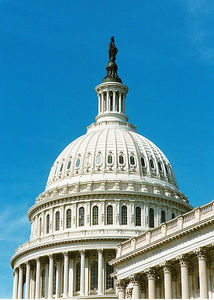 Imlay has assured ARRL members that the Parity Act would be beneficial to the many thousands of amateurs now living in deed-restricted communities, as it would allow those hams to erect effective outdoor antennas notwithstanding the preclusive language of covenants or homeowner association (HOA) regulations.
Imlay has assured ARRL members that the Parity Act would be beneficial to the many thousands of amateurs now living in deed-restricted communities, as it would allow those hams to erect effective outdoor antennas notwithstanding the preclusive language of covenants or homeowner association (HOA) regulations. Sponsored by
Sponsored by 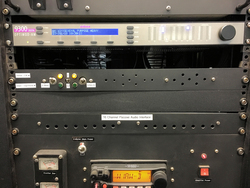 W1AW Station Manager Joe Carcia, NJ1Q, installed the 9300 OPTIMOD-AM into W1AW's audio chain. After making necessary setup adjustments and working with instructions that Pappas provided, he determined that overall average modulation had increased and audio clarity was improved.
W1AW Station Manager Joe Carcia, NJ1Q, installed the 9300 OPTIMOD-AM into W1AW's audio chain. After making necessary setup adjustments and working with instructions that Pappas provided, he determined that overall average modulation had increased and audio clarity was improved..JPG) Taylor was quick to point out that the new capabilities are not yet publicly available, not even in beta form. He said that he, Steve Franke, K9AN, and Bill Somerville, G4WJS, have been developing "enhanced versions of the MSK144 and FT8 protocols that extend the message payload to 77 bits."
Taylor was quick to point out that the new capabilities are not yet publicly available, not even in beta form. He said that he, Steve Franke, K9AN, and Bill Somerville, G4WJS, have been developing "enhanced versions of the MSK144 and FT8 protocols that extend the message payload to 77 bits." Already available are downloadable certificates for the 2017 IARU HF Championship, the 2017 ARRL 222 MHz and Up Distance Contest, and the 2017 ARRL September VHF Contest. Jahnke said the new online certificates will offer enhanced content over what has been previously available on ARRL certificates. New recognitions have been added for Top 10 participants in a broader number of geographical (country, Division, Section) or categorical entries.
Already available are downloadable certificates for the 2017 IARU HF Championship, the 2017 ARRL 222 MHz and Up Distance Contest, and the 2017 ARRL September VHF Contest. Jahnke said the new online certificates will offer enhanced content over what has been previously available on ARRL certificates. New recognitions have been added for Top 10 participants in a broader number of geographical (country, Division, Section) or categorical entries.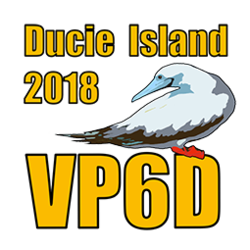 The VP6D team said it is planning to use FT8 as part of its mode mix on Ducie. "There's no question that the Baker team had considerable success with FT8," the VP6D release said. "However, a large percentage of the callers weren't prepared for the challenges of this new mode. We ask everyone to please read the
The VP6D team said it is planning to use FT8 as part of its mode mix on Ducie. "There's no question that the Baker team had considerable success with FT8," the VP6D release said. "However, a large percentage of the callers weren't prepared for the challenges of this new mode. We ask everyone to please read the 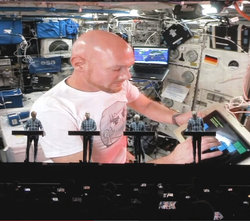 "Never thought that the first concert I [would] ever play in is with the legendary Kraftwerk, let alone jamming live from space with them, from the 'Spacelab 2.0' Columbus directly to Stuttgart," Gerst tweeted afterward. He was in the ESA Columbus module for the event, attended by about 7,500 Earthlings, and began his part of the concert by "sneaking in" the well-known five-note melody from the film, "Close Encounters of the Third Kind." As Gerst explained, "It just fit too perfectly."
"Never thought that the first concert I [would] ever play in is with the legendary Kraftwerk, let alone jamming live from space with them, from the 'Spacelab 2.0' Columbus directly to Stuttgart," Gerst tweeted afterward. He was in the ESA Columbus module for the event, attended by about 7,500 Earthlings, and began his part of the concert by "sneaking in" the well-known five-note melody from the film, "Close Encounters of the Third Kind." As Gerst explained, "It just fit too perfectly."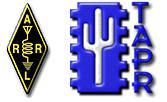 The ARRL/TAPR Digital Communications Conference (DCC) has issued another call for papers. Technical papers are sought for presentation at the DCC, set for September 14 - 16 in Albuquerque, New Mexico, and for publication in the Conference Proceedings published by ARRL. Conference presentation is not required for publication. Papers are due by July 31 to Maty Weinberg, KB1EIB, ARRL, 225 Main St., Newington, CT 06111, or via
The ARRL/TAPR Digital Communications Conference (DCC) has issued another call for papers. Technical papers are sought for presentation at the DCC, set for September 14 - 16 in Albuquerque, New Mexico, and for publication in the Conference Proceedings published by ARRL. Conference presentation is not required for publication. Papers are due by July 31 to Maty Weinberg, KB1EIB, ARRL, 225 Main St., Newington, CT 06111, or via 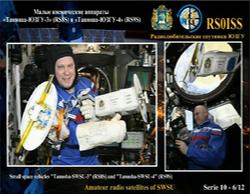 More Slow-Scan TV transmissions from the International Space Station are just ahead. Russian cosmonauts on the International Space Station are expected to activate Amateur Radio Slow-Scan Television (SSTV) transmissions on 145.800 MHz FM on July 30 and 31 The SSTV experiment should be active on Monday, July 30, 1600 - 1930 UTC, and Tuesday, July 31, 1325 - 1915 UTC, using the RS0ISS call sign. SSTV images will be transmitted using the Kenwood TM-D710 transceiver in the Russian ISS Service Module. Format is expected to be PD-120.
More Slow-Scan TV transmissions from the International Space Station are just ahead. Russian cosmonauts on the International Space Station are expected to activate Amateur Radio Slow-Scan Television (SSTV) transmissions on 145.800 MHz FM on July 30 and 31 The SSTV experiment should be active on Monday, July 30, 1600 - 1930 UTC, and Tuesday, July 31, 1325 - 1915 UTC, using the RS0ISS call sign. SSTV images will be transmitted using the Kenwood TM-D710 transceiver in the Russian ISS Service Module. Format is expected to be PD-120. 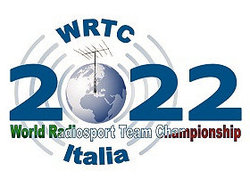 The region of Italy that is home to the birthplace of wireless pioneer Guglielmo Marconi will host the next World Radiosport Team Championship,
The region of Italy that is home to the birthplace of wireless pioneer Guglielmo Marconi will host the next World Radiosport Team Championship, .jpg) CQ World Wide Contest rules have been updated. CQ
CQ World Wide Contest rules have been updated. CQ 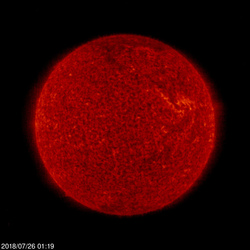 The average daily planetary A index changed from 6.4 to 8.1, and the average daily mid-latitude A index (measured in Virginia) increased from 6.1 to 8.
The average daily planetary A index changed from 6.4 to 8.1, and the average daily mid-latitude A index (measured in Virginia) increased from 6.1 to 8.







